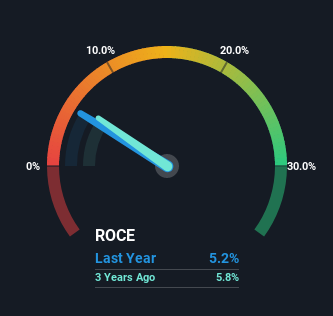- United States
- /
- Media
- /
- NasdaqGS:IHRT
iHeartMedia (NASDAQ:IHRT) Is Finding It Tricky To Allocate Its Capital
What financial metrics can indicate to us that a company is maturing or even in decline? When we see a declining return on capital employed (ROCE) in conjunction with a declining base of capital employed, that's often how a mature business shows signs of aging. This indicates the company is producing less profit from its investments and its total assets are decreasing. Having said that, after a brief look, iHeartMedia (NASDAQ:IHRT) we aren't filled with optimism, but let's investigate further.
Return On Capital Employed (ROCE): What Is It?
If you haven't worked with ROCE before, it measures the 'return' (pre-tax profit) a company generates from capital employed in its business. To calculate this metric for iHeartMedia, this is the formula:
Return on Capital Employed = Earnings Before Interest and Tax (EBIT) ÷ (Total Assets - Current Liabilities)
0.052 = US$392m ÷ (US$8.3b - US$832m) (Based on the trailing twelve months to December 2022).
Thus, iHeartMedia has an ROCE of 5.2%. Ultimately, that's a low return and it under-performs the Media industry average of 9.4%.
View our latest analysis for iHeartMedia

In the above chart we have measured iHeartMedia's prior ROCE against its prior performance, but the future is arguably more important. If you'd like to see what analysts are forecasting going forward, you should check out our free report for iHeartMedia.
What The Trend Of ROCE Can Tell Us
The trend of returns that iHeartMedia is generating are raising some concerns. The company used to generate 6.6% on its capital four years ago but it has since fallen noticeably. On top of that, the business is utilizing 32% less capital within its operations. The combination of lower ROCE and less capital employed can indicate that a business is likely to be facing some competitive headwinds or seeing an erosion to its moat. If these underlying trends continue, we wouldn't be too optimistic going forward.
What We Can Learn From iHeartMedia's ROCE
To see iHeartMedia reducing the capital employed in the business in tandem with diminishing returns, is concerning. Long term shareholders who've owned the stock over the last three years have experienced a 49% depreciation in their investment, so it appears the market might not like these trends either. With underlying trends that aren't great in these areas, we'd consider looking elsewhere.
On a final note, we found 2 warning signs for iHeartMedia (1 is a bit concerning) you should be aware of.
If you want to search for solid companies with great earnings, check out this free list of companies with good balance sheets and impressive returns on equity.
Valuation is complex, but we're here to simplify it.
Discover if iHeartMedia might be undervalued or overvalued with our detailed analysis, featuring fair value estimates, potential risks, dividends, insider trades, and its financial condition.
Access Free AnalysisHave feedback on this article? Concerned about the content? Get in touch with us directly. Alternatively, email editorial-team (at) simplywallst.com.
This article by Simply Wall St is general in nature. We provide commentary based on historical data and analyst forecasts only using an unbiased methodology and our articles are not intended to be financial advice. It does not constitute a recommendation to buy or sell any stock, and does not take account of your objectives, or your financial situation. We aim to bring you long-term focused analysis driven by fundamental data. Note that our analysis may not factor in the latest price-sensitive company announcements or qualitative material. Simply Wall St has no position in any stocks mentioned.
About NasdaqGS:IHRT
Undervalued with moderate growth potential.
Similar Companies
Market Insights
Community Narratives



